fuel TOYOTA HIGHLANDER 2020 Owners Manual (in English)
[x] Cancel search | Manufacturer: TOYOTA, Model Year: 2020, Model line: HIGHLANDER, Model: TOYOTA HIGHLANDER 2020Pages: 560, PDF Size: 14.42 MB
Page 1 of 560

1
2
3
4
5
6
7
8
9
9
HIGHLANDER_U
Pictorial indexSearch by illustration
For safety
and securityMake sure to read through them
(Main topics: Child seat, theft deterrent system)
Vehicle status
information and
indicatorsReading driving-related information
(Main topics: Meters, multi-information display)
Before driving
Opening and closing the doors and windows,
adjustment before driving
(Main topics: Keys, doors, seats)
Driving
Operations and advice which are necessary for
driving
(Main topics: Starting engine, refueling)
Interior featuresUsage of the interior features
(Main topics: Air conditioner, storage features)
Maintenance
and careCaring for your vehicle and maintenance
procedures
(Main topics: Interior and exterior, light bulbs)
When trouble
arisesWhat to do in case of malfunction and emergency
(Main topics: Battery discharge, flat tire)
Vehicle
specificationsVehicle specifications, customizable features
(Main topics: Fuel, oil, tire inflation pressure)
For ownersReporting safety defects for U.S. owners, and seat
belt, SRS airbag and headlight aim instructions for
Canadian owners
IndexSearch by symptom
Search alphabetically
Page 2 of 560
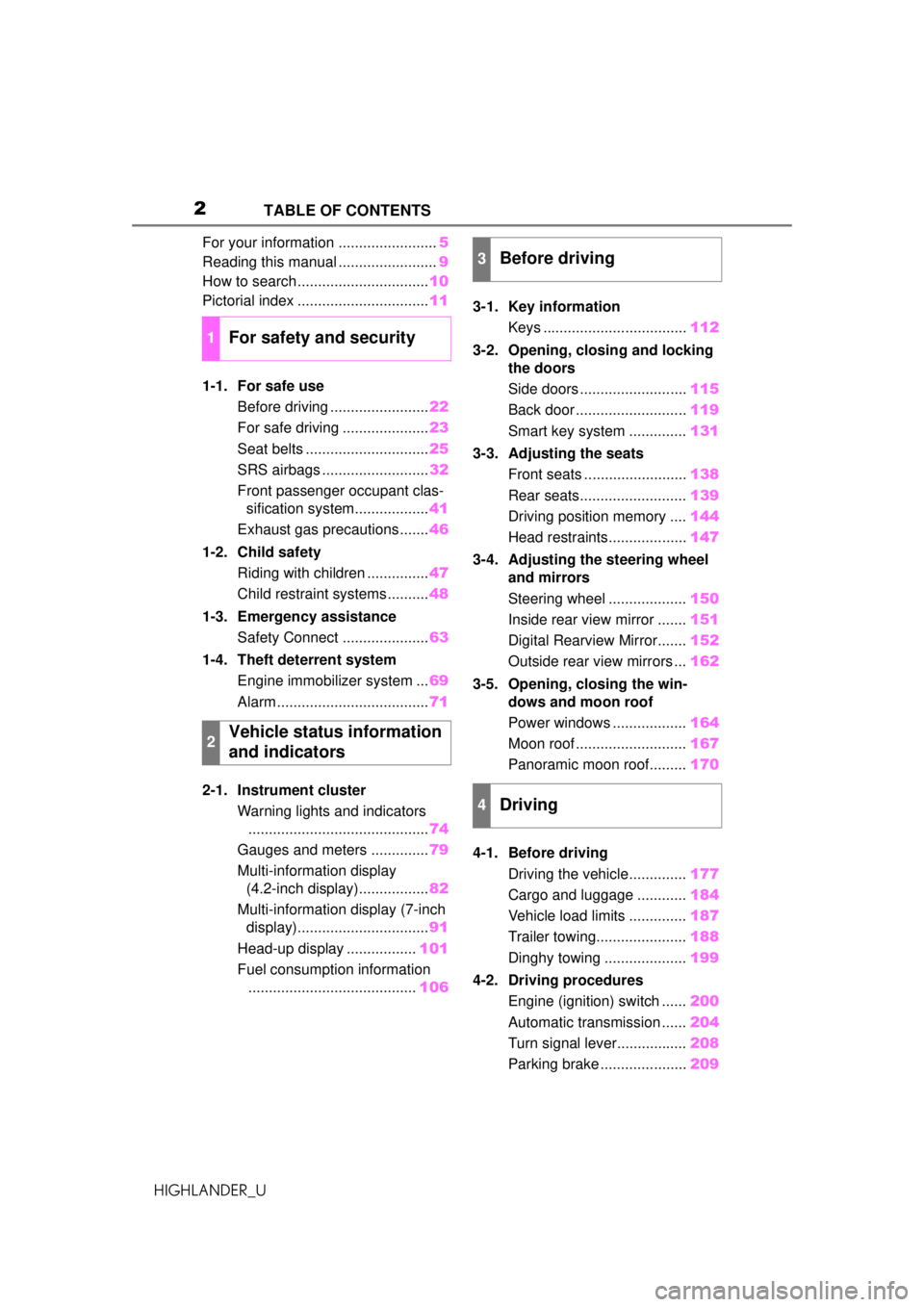
2
HIGHLANDER_UTABLE OF CONTENTS
For your information ........................
5
Reading this manual ........................ 9
How to search ................................ 10
Pictorial index ................................ 11
1-1. For safe use Before driving ........................ 22
For safe driving ..................... 23
Seat belts .............................. 25
SRS airbags .......................... 32
Front passenger occupant clas- sification system.................. 41
Exhaust gas precautions....... 46
1-2. Child safety Riding with children ............... 47
Child restraint systems .......... 48
1-3. Emergency assistance Safety Connect ..................... 63
1-4. Theft deterrent system Engine immobilizer system ... 69
Alarm ..................................... 71
2-1. Instrument cluster Warning lights and indicators............................................ 74
Gauges and meters .............. 79
Multi-information display (4.2-inch display)................. 82
Multi-information display (7-inch display)................................ 91
Head-up display ................. 101
Fuel consumption information ......................................... 1063-1. Key information
Keys ................................... 112
3-2.
Opening, closing and locking
th
e doors
Side doors .......................... 115
Back door ........................... 119
Smart key system .............. 131
3-3. Adjusting the seats Front seats ......................... 138
Rear seats.......................... 139
Driving position memory .... 144
Head restraints................... 147
3-4. Adjust
ing the steering wheel
and mirrors
Ste
ering wheel ...................150
Inside rear view mirror ....... 151
Digital Rearview Mirror....... 152
Outside rear view mirrors ... 162
3-5. Opening, closing the win- dows and moon roof
Power windows .................. 164
Moon roof ........................... 167
Panoramic moon roof......... 170
4-1. Before driving Driving the vehicle.............. 177
Cargo and luggage ............ 184
Vehicle load limits .............. 187
Trailer towing...................... 188
Dinghy towing .................... 199
4-2. Driving procedures Engine
(ignition) switch ...... 200
Automatic transmission ...... 204
Turn signal lever................. 208
Parking brake ..................... 209
1For safety and security
2Vehicle status information
and indicators
3Before driving
4Driving
Page 3 of 560
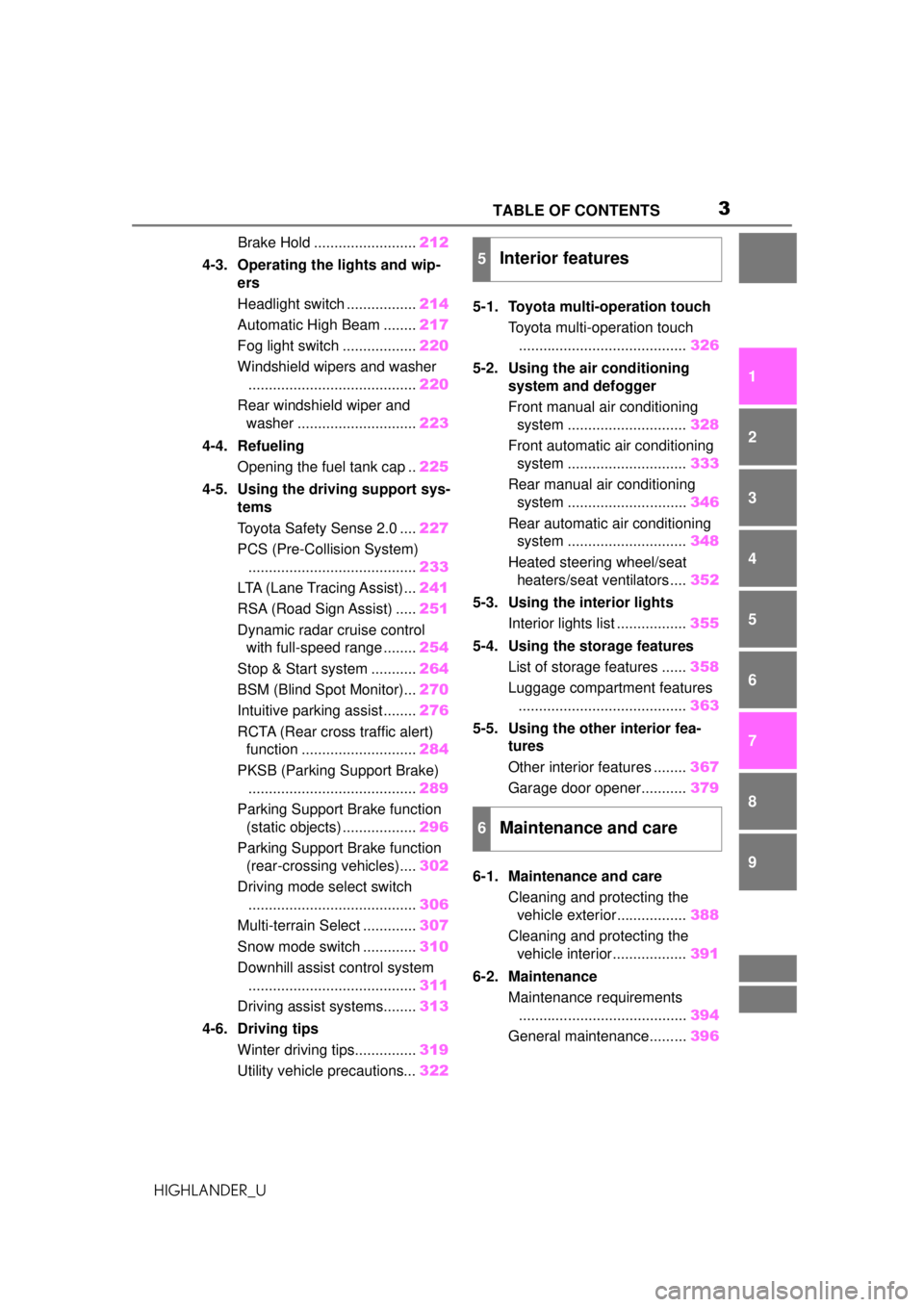
3TABLE OF CONTENTS
HIGHLANDER_U
1
2
3
4
5
6
7
8
9
10
Brake Hold ......................... 212
4-3. Operating the lights and wip- ers
Headlight switch ................. 214
Automatic High Beam ........ 217
Fog light switch .................. 220
Windshield wipers and washer ......................................... 220
Rear windshield wiper and washer ............................. 223
4-4. Refueling Opening the fuel tank cap .. 225
4-5. Using the driving support sys- tems
Toyota Safety Sense 2.0 .... 227
PCS (Pre-Collision System) ......................................... 233
LTA (Lane Tracing Assist)... 241
RSA (Road Sign Assist) ..... 251
Dynamic radar cruise control with full-speed range ........ 254
Stop & Start system ........... 264
BSM (Blind Spot Monitor)... 270
Intuitive parking assist ........ 276
RCTA (Rear cross traffic alert) function ............................ 284
PKSB (Parking Support Brake) ......................................... 289
Parking Support Brake function (static objects) .................. 296
Parking Support Brake function (rear-crossing vehicles).... 302
Driving mode select switch ......................................... 306
Multi-terrain Select ............. 307
Snow mode switch ............. 310
Downhill assist control system ......................................... 311
Driving assist systems........ 313
4-6. Driving tips Winter driving tips............... 319
Utility vehicle precautions... 3225-1. Toyota multi-operation touch
Toyota multi-operation touch......................................... 326
5-2. Using the air conditioning system and defogger
Front manual air conditioning
system ............................. 328
Front automatic air conditioning system ............................. 333
Rear manual air conditioning system ............................. 346
Rear automatic air conditioning system ............................. 348
Heated steering wheel/seat heaters/seat ventilators.... 352
5-3. Using the interior lights Interior lights list ................. 355
5-4. Using the storage features List of storage features ...... 358
Luggage compartment features ......................................... 363
5-5. Using the other interior fea- tures
Other interior features ........ 367
Garage do or opener
........... 379
6-1. Maintenance and care Cleaning and protecting the vehicle exterior................. 388
Cleaning and protecting the vehicle interior.................. 391
6-2. Maintenance Maintenance requirements......................................... 394
General maintenance......... 396
5Interior features
6Maintenance and care
Page 4 of 560
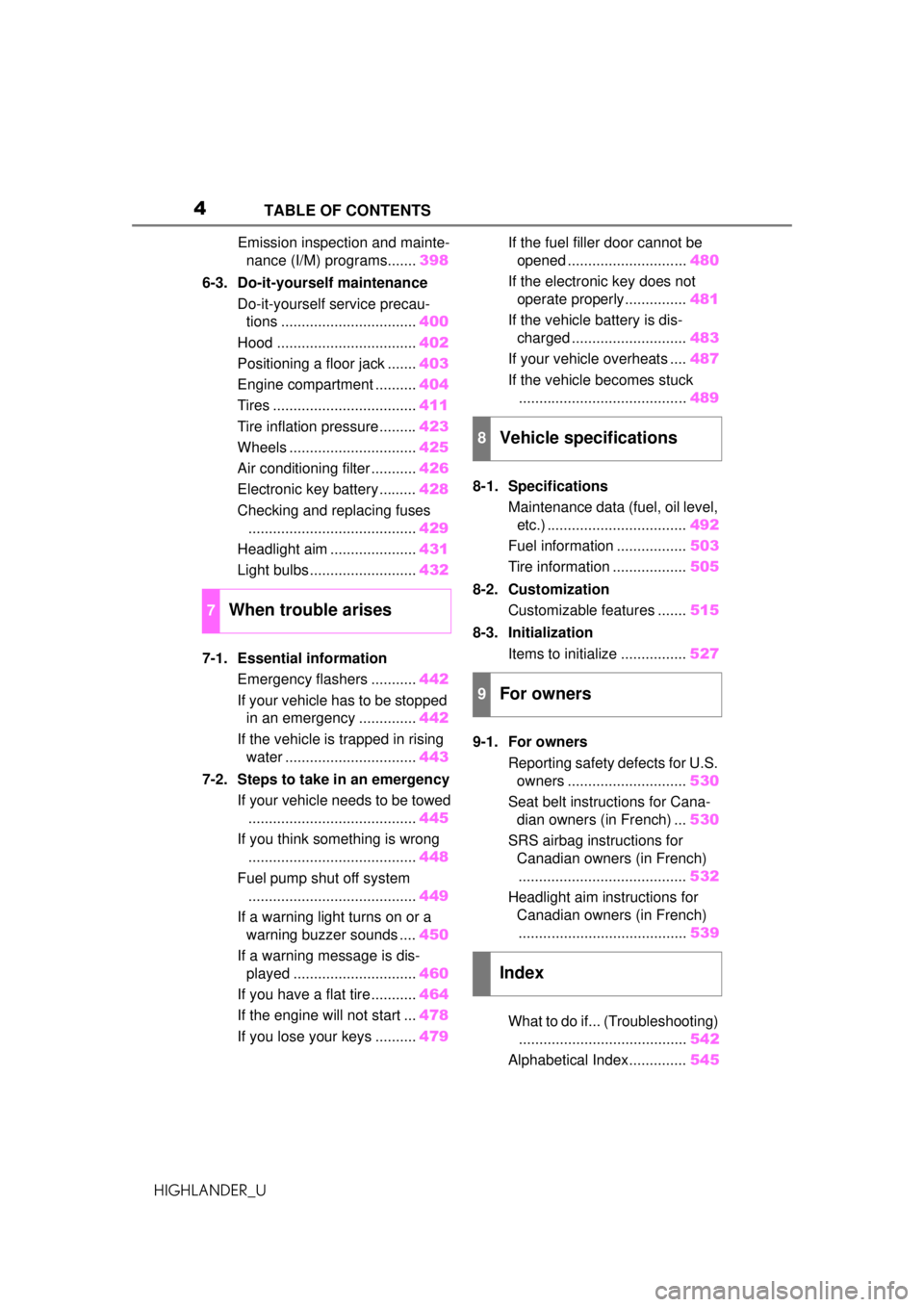
4TABLE OF CONTENTS
HIGHLANDER_U
Emission inspection and mainte-nance (I/M) programs....... 398
6-3. Do-it-yourself maintenance Do-it-yourself service precau-tions ................................. 400
Hood .................................. 402
Positioning a floor jack ....... 403
Engine compartment .......... 404
Tires ................................... 411
Tire inflation pressure......... 423
Wheels ............................... 425
Air conditioning filter ........... 426
Electronic key battery ......... 428
Checking and replacing fuses ......................................... 429
Headlight aim ..................... 431
Light bulbs .......................... 432
7-1. Essential information Emergency flashers ........... 442
If your vehicle has to be stopped in an emergency .............. 442
If the vehicle is trapped in rising water ................................ 443
7-2. Steps to take in an emergency If your vehicle needs to be towed......................................... 445
If you think something is wrong ......................................... 448
Fuel pump shut off system ......................................... 449
If a warning light turns on or a warning buzzer sounds .... 450
If a warning message is dis- played .............................. 460
If you have a flat tire ........... 464
If the engine will not start ... 478
If you lose your keys .......... 479If the fuel filler door cannot be
opened ............................. 480
If the electronic key does not operate properly............... 481
If the vehicle battery is dis- charged ............................ 483
If your vehicle overheats .... 487
If the vehicle becomes stuck ......................................... 489
8-1. Specifications Maintenance data (fuel, oil level, etc.) .................................. 492
Fuel information ................. 503
Tire information .................. 505
8-2. Customization Customizable features ....... 515
8-3. Initialization Items to initialize ................ 527
9-1. For owners Reporting safety defects for U.S. owners ............................. 530
Seat belt instructions for Cana- dian owners (in French) ... 530
SRS airbag instructions for Canadian owners (in French)......................................... 532
Headlight aim instructions for Canadian owners (in French)
........ ................................. 53
9
What to do if... (Troubleshooting) ......................................... 542
Alphabetical Index.............. 545
7When trouble arises
8Vehicle specifications
9For owners
Index
Page 5 of 560

5
HIGHLANDER_U
Please note that this manual
applies to explains all models
and all equipment, including
options. Therefore, you may find
some explanations for equip-
ment not installed on your vehi-
cle.
All specifications provided in this
manual are current at the time of
printing. However, because of
the Toyota policy of continual
product improvement, we
reserve the right to make
changes at any time without
notice.
Depending on specifications,
the vehicle shown in the illustra-
tions may differ from your vehi-
cle in terms of color and
equipment.
Approximately five hours after
the engine is turned off, you
may hear sound coming from
under the vehicle for several
minutes. This is the sound of a
fuel evaporation leakage check
and, it does not indicate a mal-
function.A wide variety of non-genuine
spare parts and accessories for
Toyota vehicles are currently
available in the market. You
should know that Toyota does
not warrant these products and
is not responsible for their per-
formance, repair, or replace-
ment, or for any damage they
may cause to, or adverse effect
they may have on, your Toyota
vehicle.
This vehicle should not be modi-
fied with non-genuine Toyota
products. Modification with
non-genuine Toyota products
could affect its performance,
safety or durability, and may
even violate governmental regu-
lations. In addition, damage or
performance problems resulting
from the modification may not
be covered under warranty.
The installation of a mobile
two-way radio system in your
vehicle could affect electronic
systems such as:
Multiport fuel injection sys-
tem/sequential multiport fuel
injection system
Toyota Safety Sense 2.0
For your information
Main Owner’s Manual
Noise from under vehicle
after turning off the engine
Accessories, spare parts
and modification of your
To y o t a
Installation of a mobile
two-way radio system
Page 12 of 560

12Pictorial index
HIGHLANDER_U
Precautions for winter season.... .......................................... P.319
To prevent freezing (windshield wiper de-icer) ............. P.330, 335
Precautions for car wash
*.................................................... P.389
Fuel filler door .................................................................... P.225
Refueling method ................................................................. P.225
Fuel type/fuel tank capacity ................................................. P.495
Tires..................................................................................... P.411
Tire size/inflation pressure ........................................... P.411, 499
Winter tires/tire chains ......................................................... P.319
Checking/rotation/tire pressure warning system .................. P.411
Coping with flat tires............................................................. P.464
Hood .................................................................................... P.402
Opening ............................................................................... P.402
Engine oil ............................................................................. P.495
Coping with overheating ...................................................... P.487
Warning messages .............................................................. P.460
Headlights........................................................................... P.214
Parking lights ..................................................................... P.214
Front turn signal lights ...................................................... P.208
Parking lights
*/daytime running lights............................. P.214
Front side marker lights .................................................... P.214
Front fog lights
*.................................................................. P.220
Stop/tail lights .................................................................... P.214
Tail lights............................................................................. P.214
Back-up lights
Shifting the shift lever to R ................................................... P.204
License plate lights............................................................ P.214
Rear turn signal lights ....................................................... P.208
Light bulbs of the exterior lights for driving
(Replacing method: P.432, Watts: P.501)
Page 15 of 560
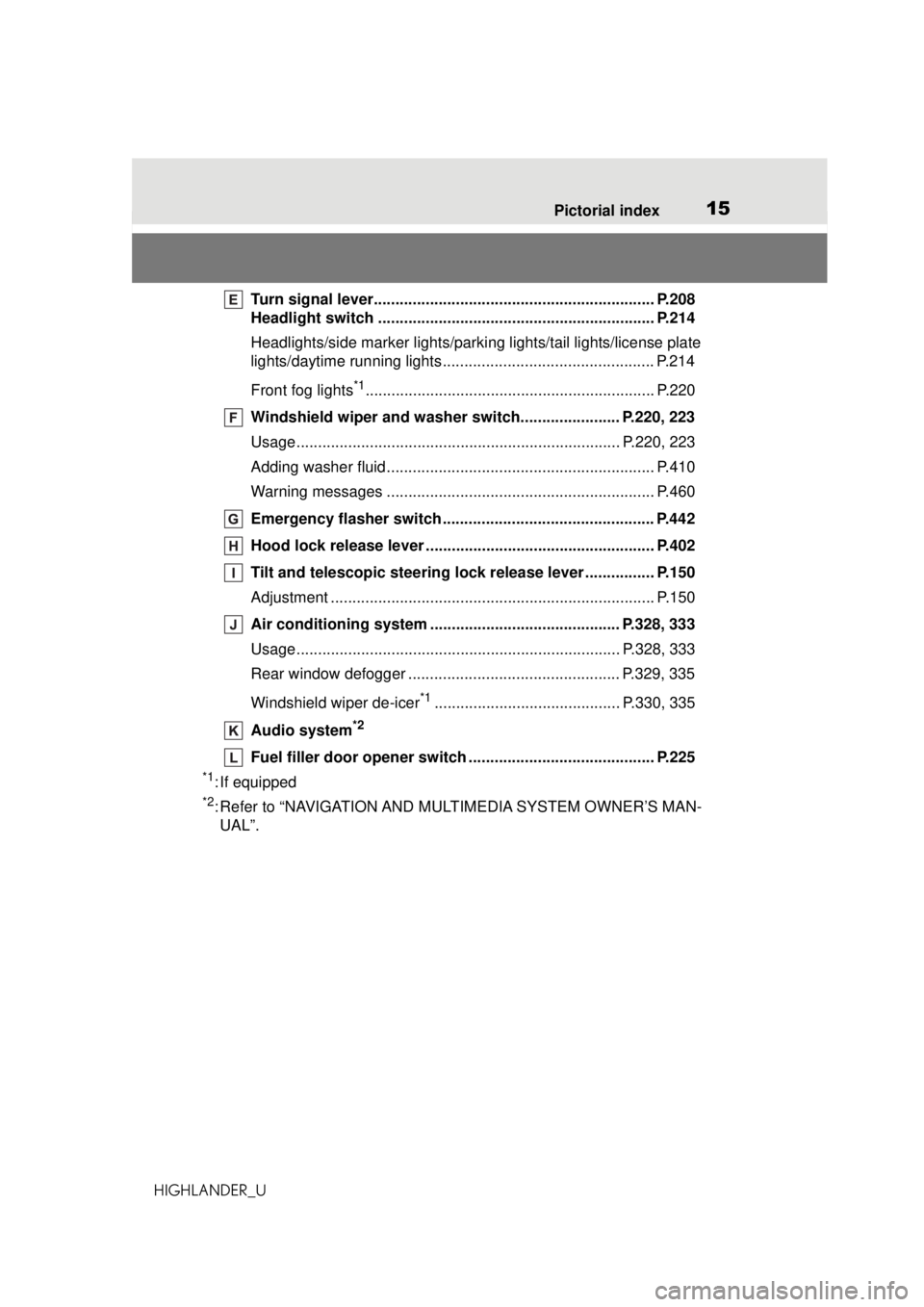
15Pictorial index
HIGHLANDER_U
Turn signal lever................................................................. P.208
Headlight switch ................................................................ P.214
Headlights/side marker lights/park ing lights/tail lights/license plate
lights/daytime running lights ................................................. P.214
Front fog lights
*1................................................................... P.220
Windshield wiper and washer switch....................... P.220, 223
Usage........................................................................... P.220, 223
Adding washer fluid .............................................................. P.410
Warning messages .............................................................. P.460
Emergency flasher switch ................................................. P.442
Hood lock releas e lever .............................................. ....... P.402
Tilt and telescopic steering lo ck release lever ................ P.150
Adjustment ........................................................................... P.150
Air conditioning system ................................. ........... P.328, 333
Usage........................................................................... P.328, 333
Rear window defogger ................................................. P.329, 335
Windshield wiper de-icer
*1........................................... P.330, 335
Audio system
*2
Fuel filler door opener switch ........................................... P.225
*1: If equipped
*2: Refer to “NAVIGATION AND MU LTIMEDIA SYSTEM OWNER’S MAN-
UAL”.
Page 34 of 560

341-1. For safe use
HIGHLANDER_U
Your vehicle is equipped with ADVANCED AIRBAGS designed
based on the US motor vehicle safety standards (FMVSS208). The
airbag sensor assembly (ECU) controls airbag deployment based on
information obtained from the sensors etc. shown in the system
components diagram above. This information includes crash sever-
ity and occupant information. As the airbags deploy, a chemical
reaction in the inflators quickly fills the airbags with non-toxic gas to
help restrain the motion of the occupants.
■If the SRS airbags deploy
(inflate)
●Slight abrasions, burns, bruising
etc., may be sustained from SRS
airbags, due to the extremely high
speed deployment (inflation) by
hot gases.
●A loud noise and white powder will
be emitted.
●Parts of the airbag module (steer-
ing wheel hub, airbag cover and
inflator) as well as the front seats,
parts of the front and rear pillars,
and roof side rails, may be hot for
several minutes. The airbag itself
may also be hot.
●The windshield may crack.
●All of the doors will be unlocked.
( P.116)
●The brakes and st op lights will be
controlled automatically. ( P.314)
●The interior lights will turn on auto-
matically. ( P.357)
●The emergency flashers will turn
on automatically. ( P.442)
●Fuel supply to the engine will be
stopped. ( P.449)
●For Safety Connect subscribers, if
any of the following situations
occur, the system is designed to
send an emergency call to the
response center, notifying them of
the vehicle’s location (without
needing to push the “SOS” button)
and an agent will a ttempt to speak
with the occupants to ascertain
the level of emergency and assis-
tance required. If the occupants are unable to communicate, the
agent automatically treats the call
as an emergency and helps to dis-
patch the necessary emergency
services. (
P. 6 3 )
• An SRS airbag is deployed.
• A seat belt pretensioner is acti- vated.
• The vehicle is involved in a severe rear-end collision.
■SRS airbag deployment condi-
tions (SRS front airbags)
●The SRS front airbags will deploy
in the event of an impact that
exceeds the set threshold level
(the level of force corresponding
to an approximately 12 - 18 mph
[20 - 30 km/h] fr ontal collision with
a fixed wall that does not move or
deform).
However, this threshold velocity will
be considerably higher in the follow-
ing situations:
• If the vehicle strikes an object, such as a parked vehicle or sign
pole, which can move or deform
on impact
• If the vehicle is involved in an underride collision, such as a colli-
sion in which the front of the vehi-
cle “underrides”, or goes under,
the bed of a truck
●Depending on the type of collision,
it is possible that only the seat belt
pretensioners will activate.
●The SRS front airbags for the front
passenger will not activate if there
is no passenger sitting in the front
passenger seat. However, the
SRS front airbags for the front
Page 67 of 560
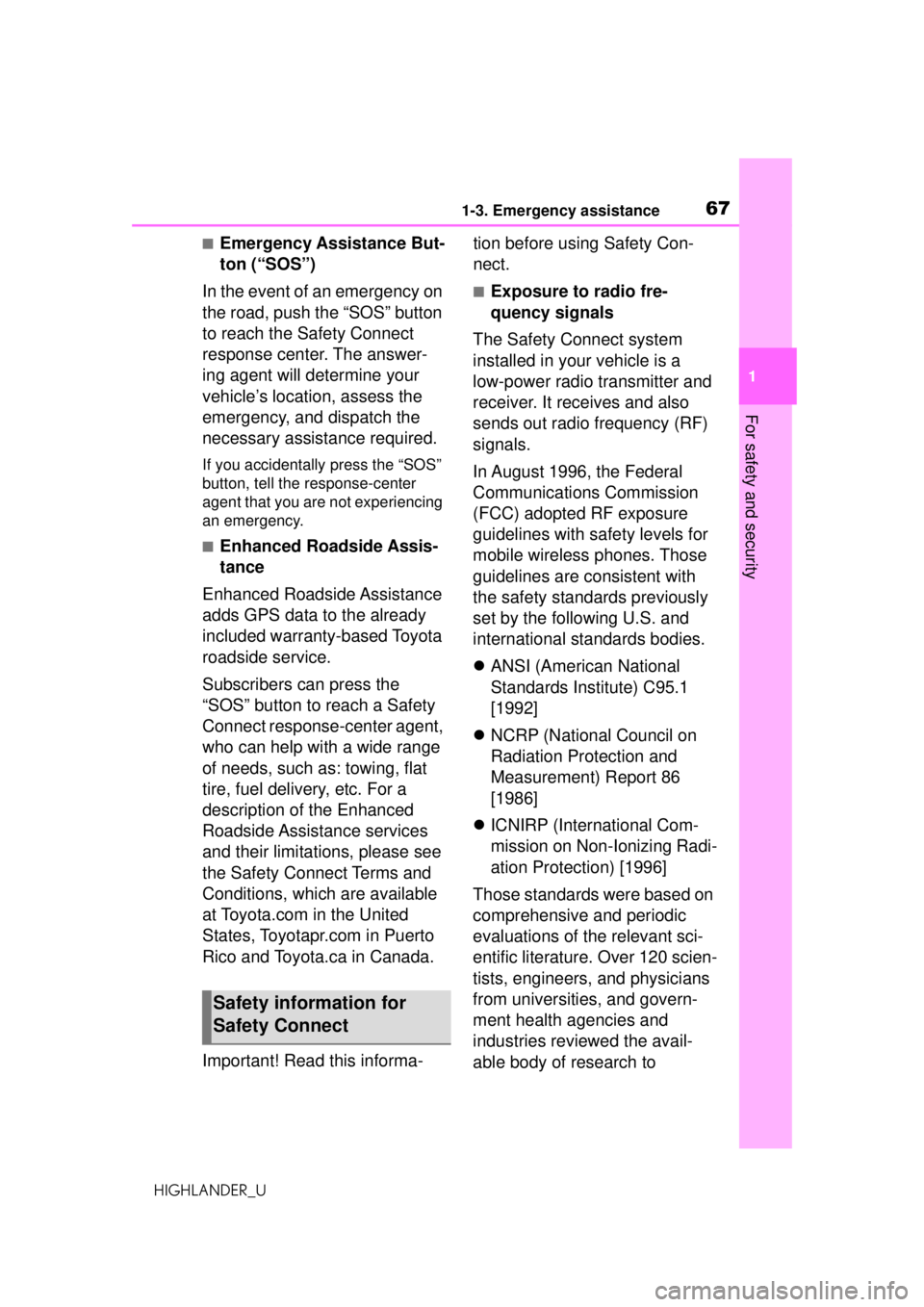
671-3. Emergency assistance
HIGHLANDER_U
1
For safety and security
■Emergency Assistance But-
ton (“SOS”)
In the event of an emergency on
the road, push the “SOS” button
to reach the Safety Connect
response center. The answer-
ing agent will determine your
vehicle’s location, assess the
emergency, and dispatch the
necessary assistance required.
If you accidentally press the “SOS”
button, tell the response-center
agent that you are not experiencing
an emergency.
■Enhanced Roadside Assis-
tance
Enhanced Roadside Assistance
adds GPS data to the already
included warranty-based Toyota
roadside service.
Subscribers can press the
“SOS” button to reach a Safety
Connect response-center agent,
who can help with a wide range
of needs, such as: towing, flat
tire, fuel delivery, etc. For a
description of the Enhanced
Roadside Assistance services
and their limitations, please see
the Safety Connect Terms and
Conditions, which are available
at Toyota.com in the United
States, Toyotapr.com in Puerto
Rico and Toyota.ca in Canada.
Important! Read this informa- tion before using Safety Con-
nect.
■Exposure to radio fre-
quency signals
The Safety Connect system
installed in your vehicle is a
low-power radio transmitter and
receiver. It receives and also
sends out radio frequency (RF)
signals.
In August 1996, the Federal
Communications Commission
(FCC) adopted RF exposure
guidelines with sa fety levels for
mobile wireless phones. Those
guidelines are consistent with
the safety standards previously
set by the following U.S. and
international standards bodies.
ANSI (American National
Standards Institute) C95.1
[1992]
NCRP (National Council on
Radiation Protection and
Measurement) Report 86
[1986]
ICNIRP (International Com-
mission on Non-Ionizing Radi-
ation Protection) [1996]
Those standards were based on
comprehensive and periodic
evaluations of the relevant sci-
entific literature. Over 120 scien-
tists, engineers, and physicians
from universities, and govern-
ment health agencies and
industries reviewed the avail-
able body of research to
Safety information for
Safety Connect
Page 73 of 560
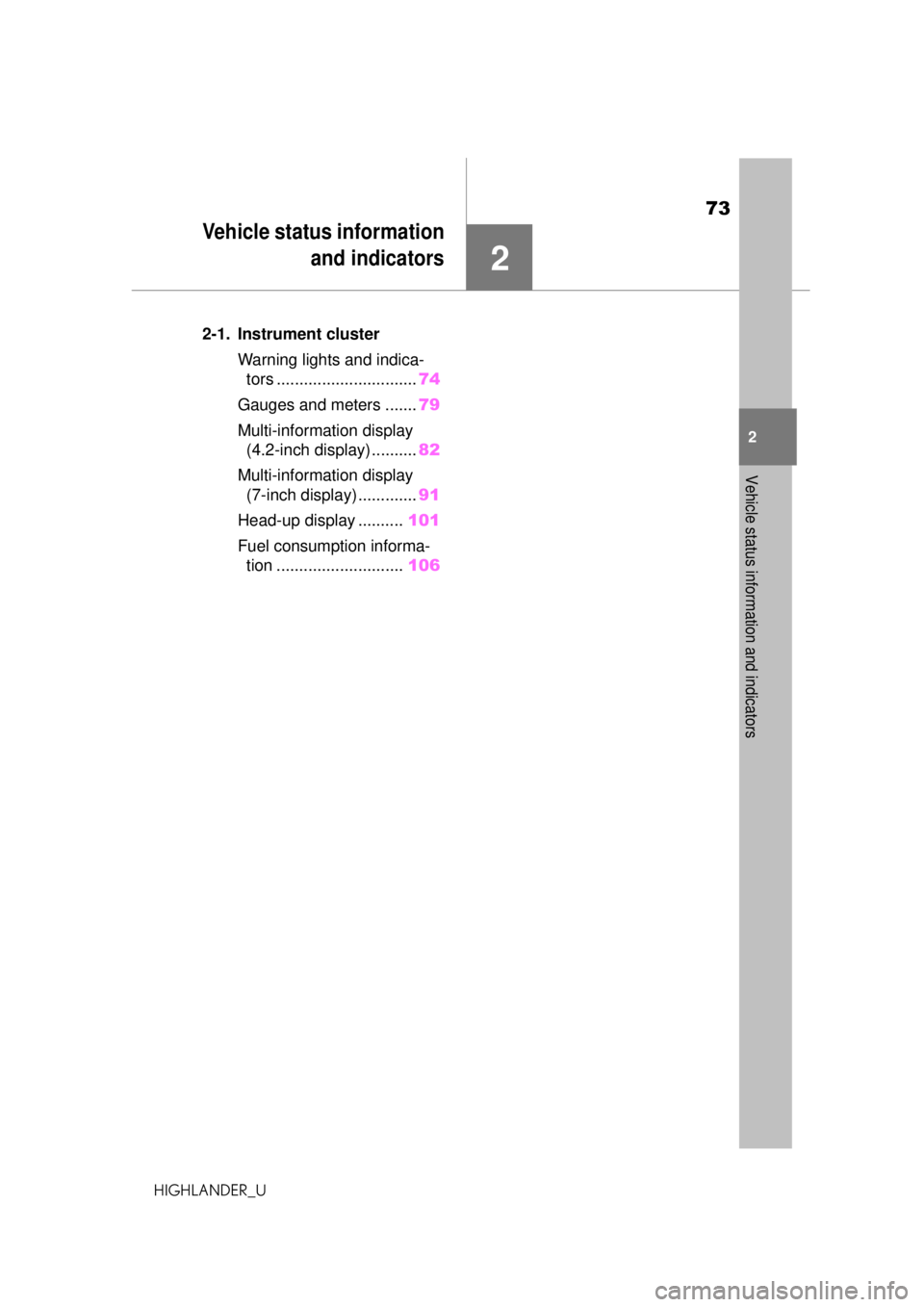
73
HIGHLANDER_U
2
2
Vehicle status information and indicators
Vehicle status informationand indicators
.2-1. Instrument cluster
Warning lights and indica-tors ............................... 74
Gauges and meters ....... 79
Multi-information display (4.2-inch display) .......... 82
Multi-information display (7-inch display) ............. 91
Head-up display .......... 101
Fuel consumption informa- tion ............................ 106